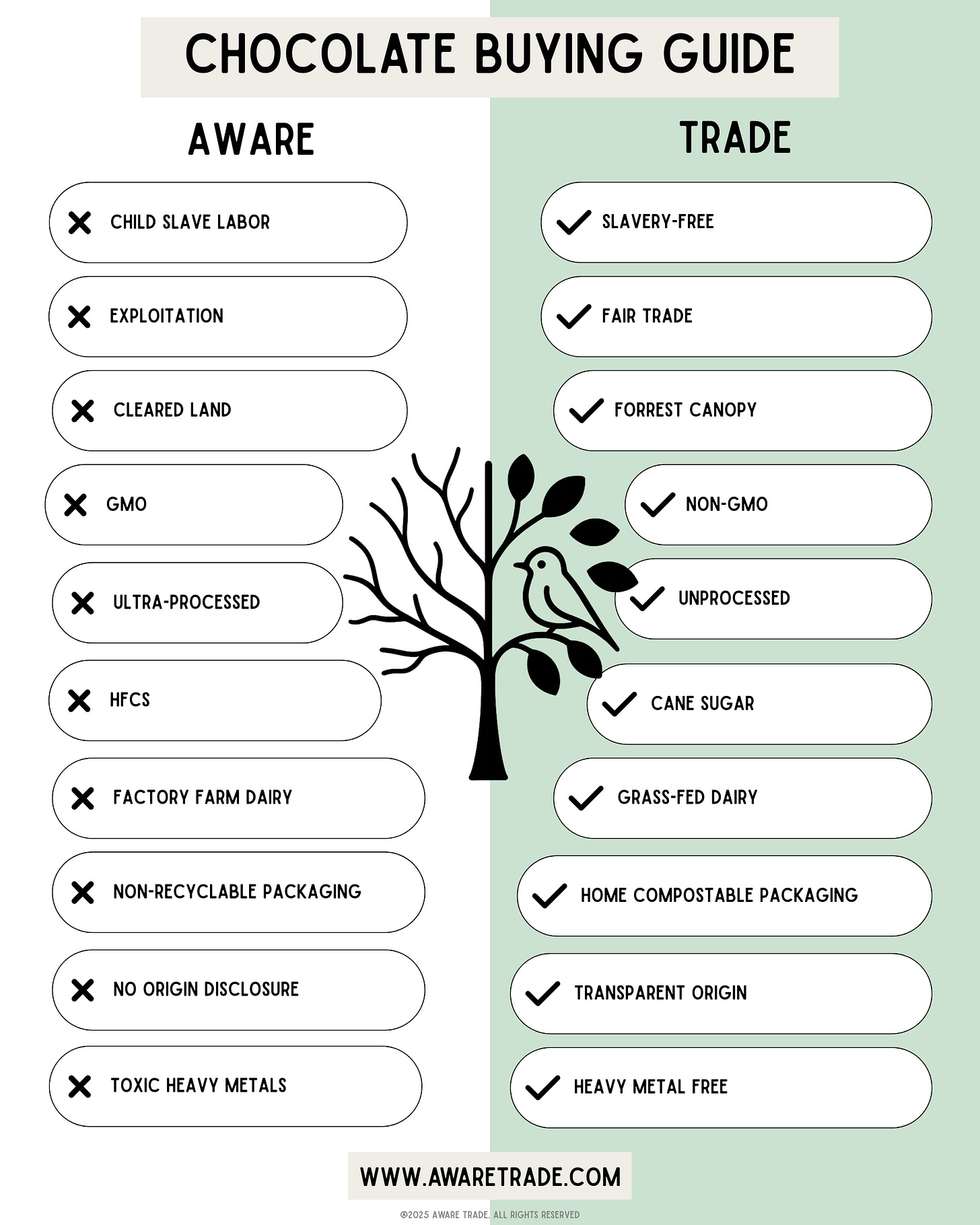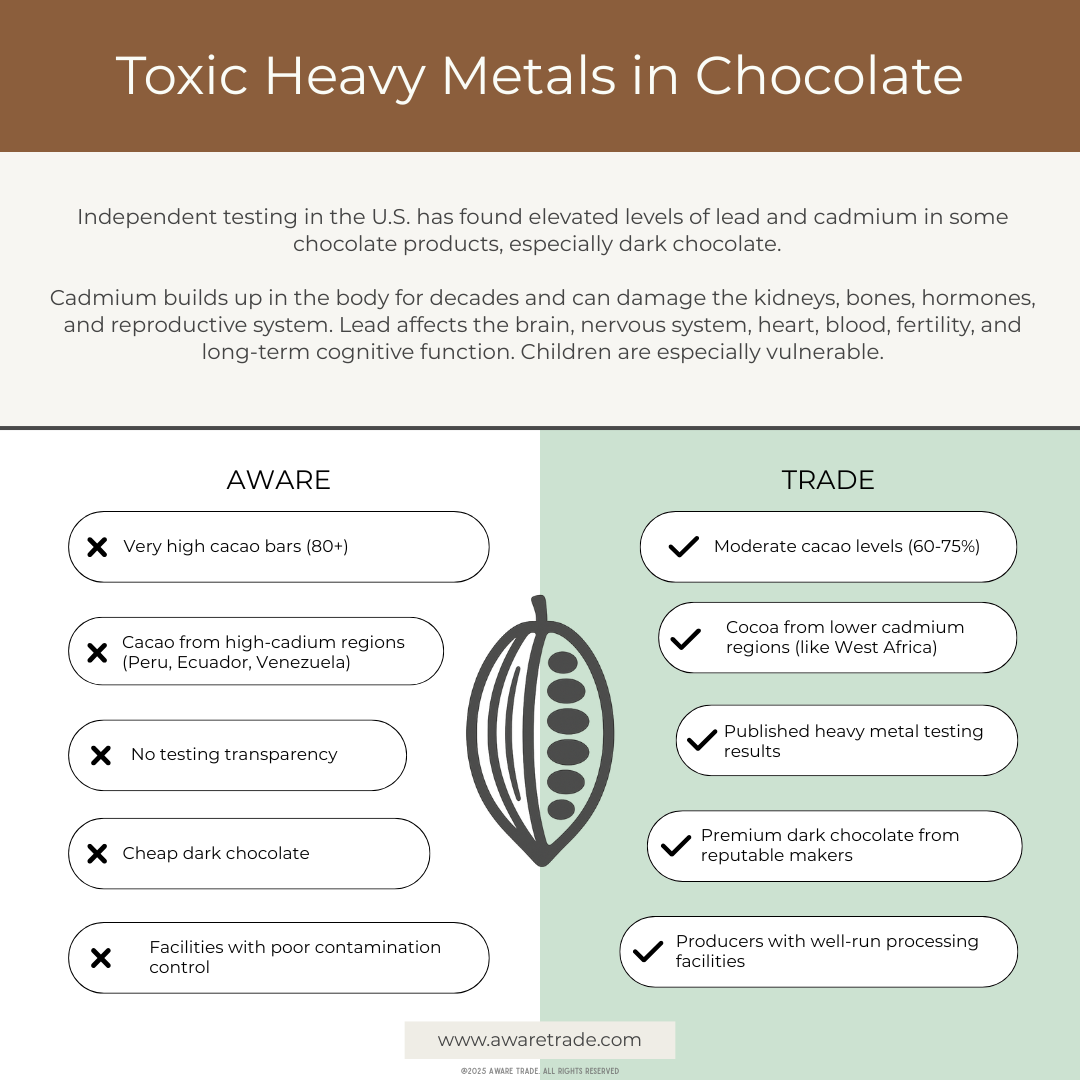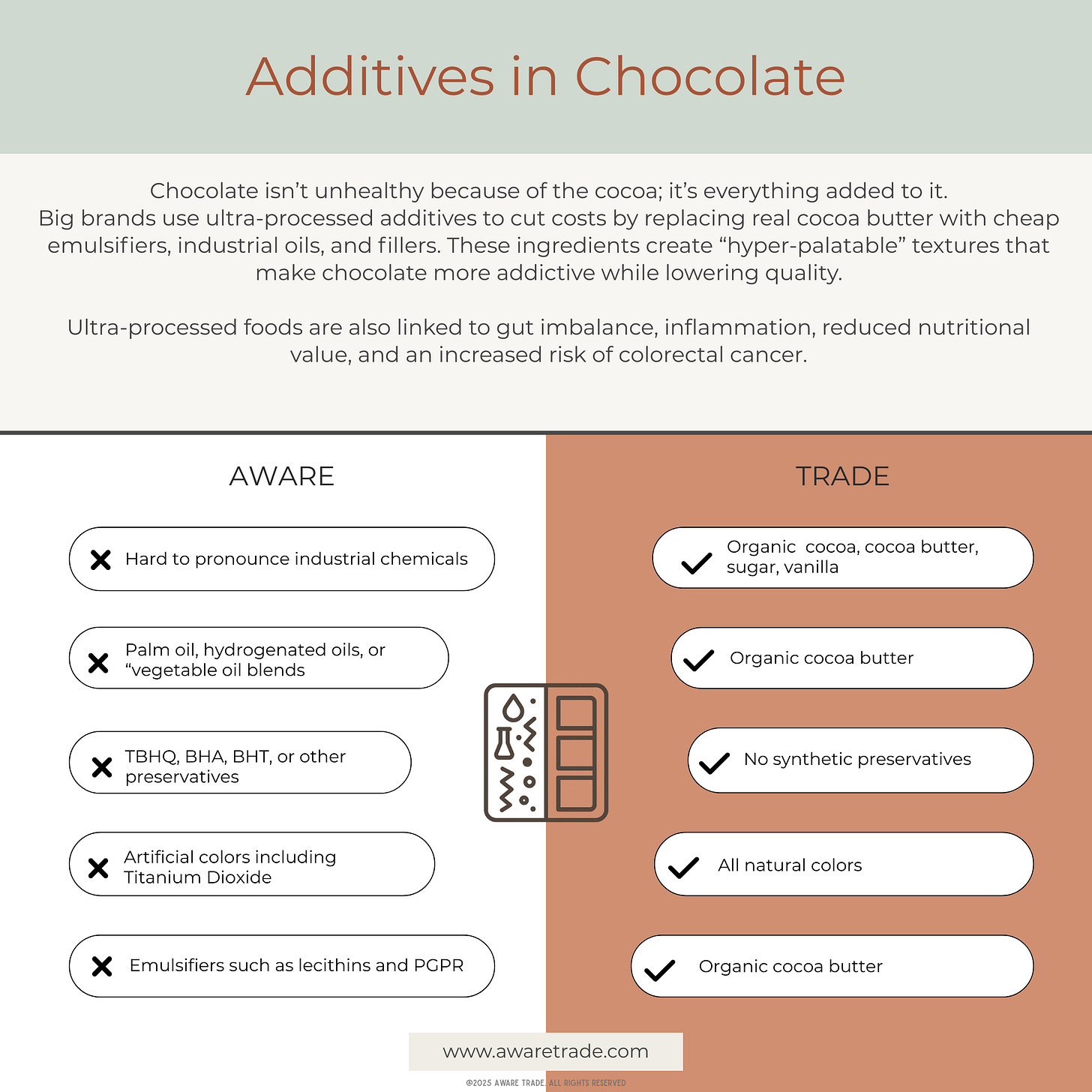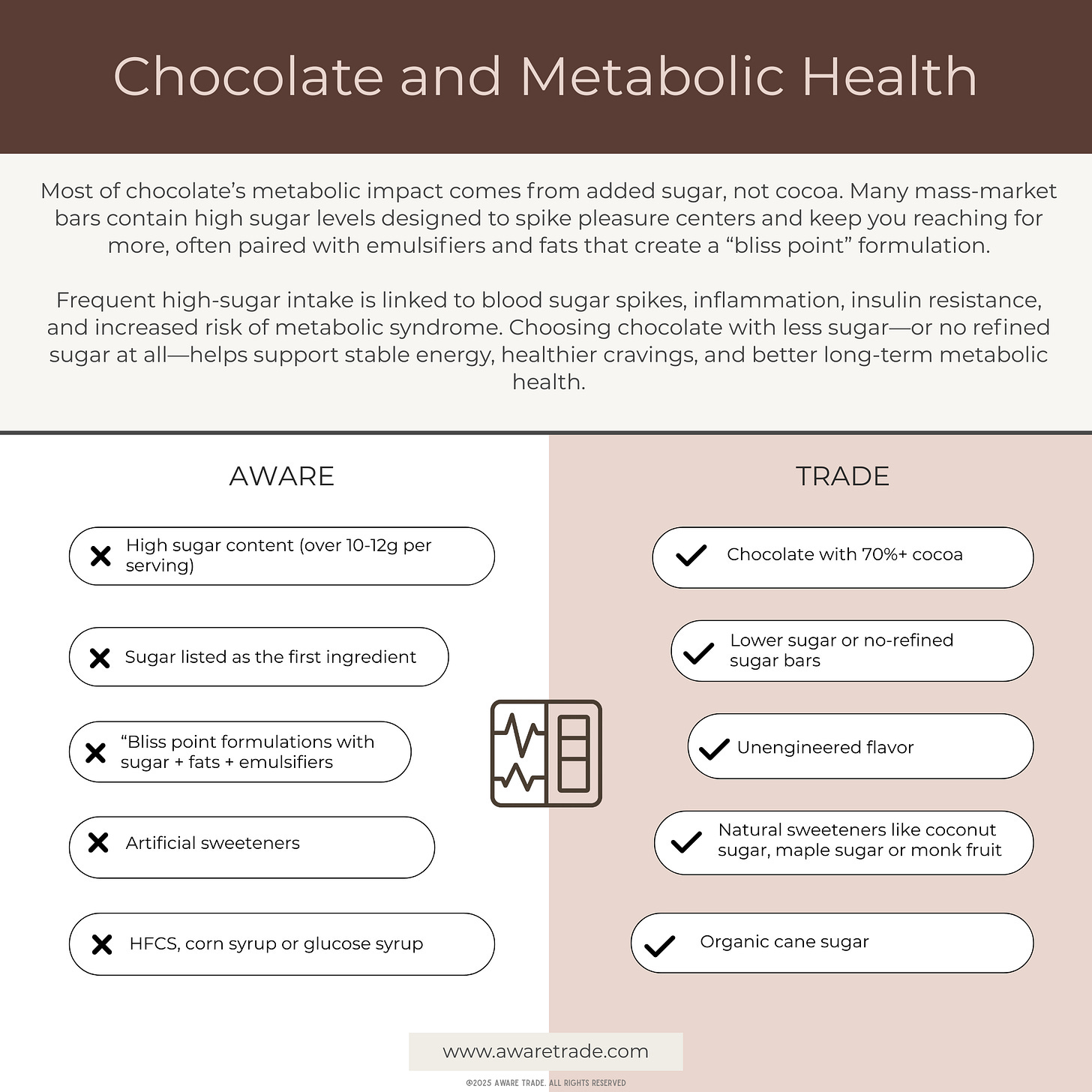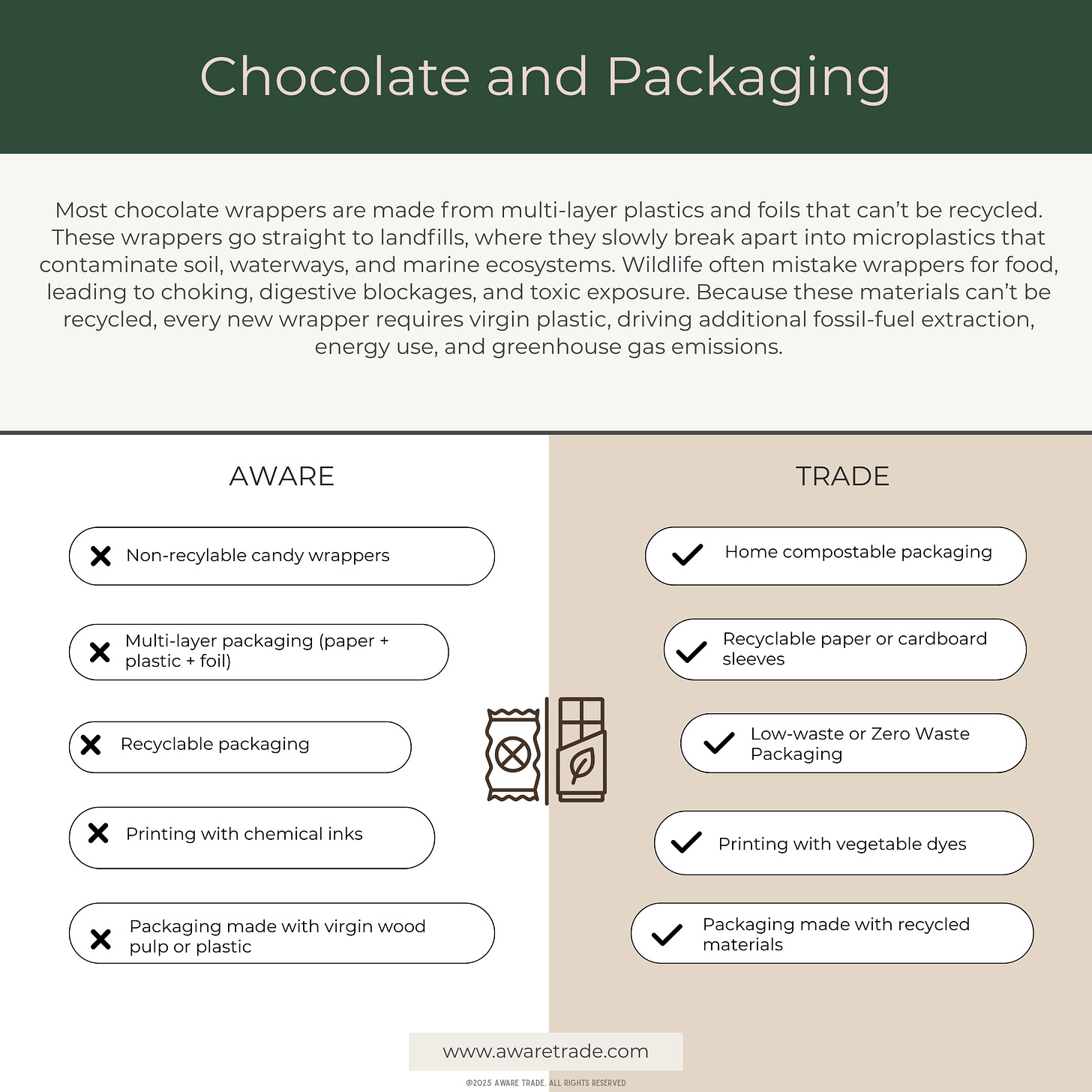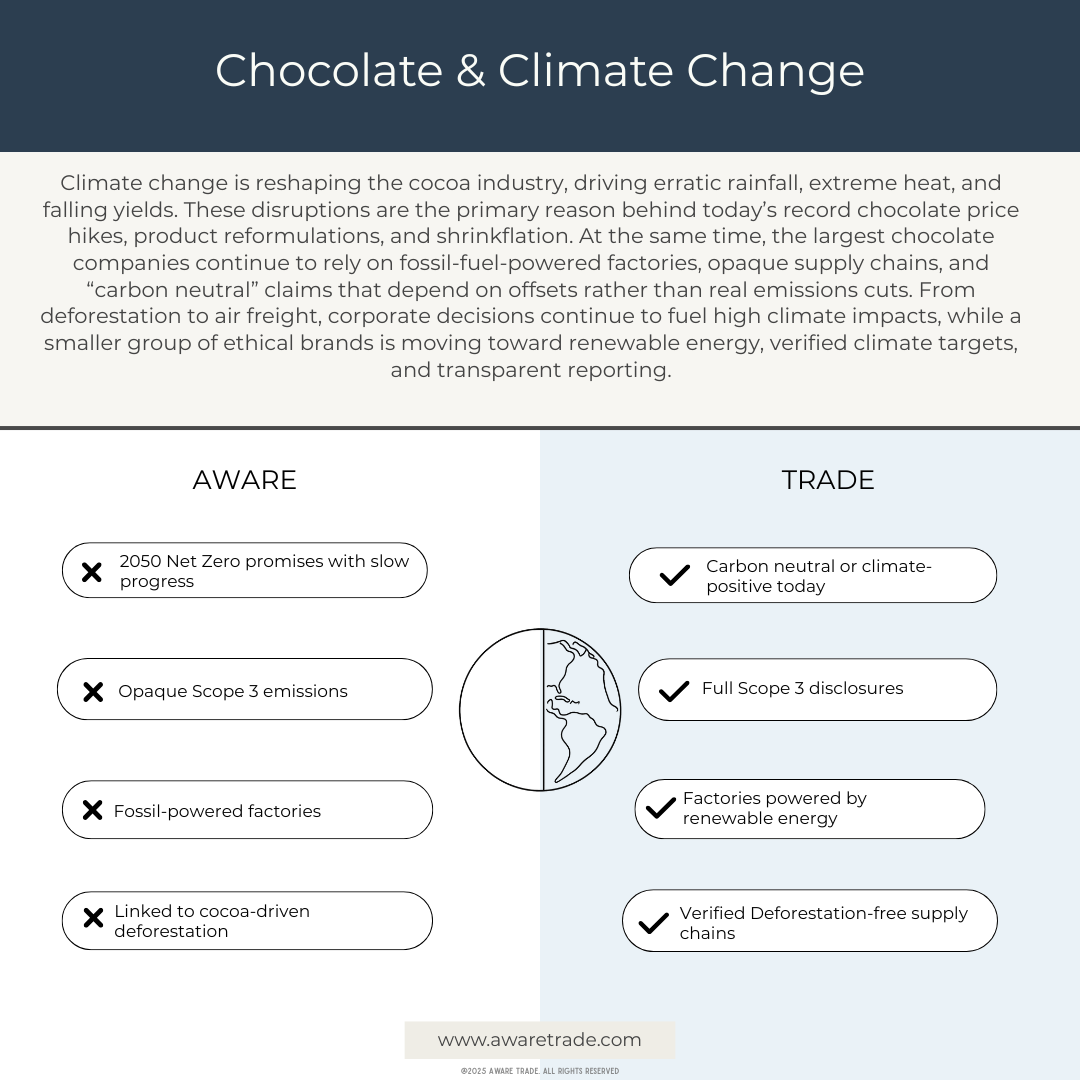The Aware Trade Guide to Chocolate
What to look for, what to avoid and the brands doing it right.
You may love chocolate, but you are not meant to see what goes into most bars. The harm behind everyday chocolate stems from a system that rewards low costs and high profits, even when that means deforestation, child labor, poverty wages, harmful additives, and massive plastic waste.
This guide helps you see chocolate not as a simple treat but as part of a larger living ecosystem. When we understand that every choice touches communities, wildlife, forests, and our own health, we begin to choose with greater clarity and compassion.
How to Choose
Fast Facts
1.5–2 million children work in cocoa globally
Cocoa farmers earn only 6–11% of a chocolate bar’s retail price
Cocoa-driven deforestation has destroyed up to 90% of Côte d’Ivoire’s rainforest and displaced entire migratory bird populations.
U.S. testing has found lead and cadmium in certain chocolate products
Most candy wrappers are not recyclable and end up in landfills or as microplastics in oceans.
Want a clear scorecard that ranks chocolate bars — from best to worst — using the ethical, environmental, and ingredient criteria in this report? Let me know in the comments.
In-Depth Analysis
Before choosing a chocolate bar, consumers deserve to understand the hidden realities behind its production, trade, and processing. This section goes beyond marketing labels to unpack the forces shaping the industry, including corporate consolidation and labor practices, environmental impacts, ingredient quality, and supply chain transparency. If you want to make informed, values-aligned choices, here’s what you need to know beneath the wrapper.
The Market
The global chocolate industry is dominated by a handful of multinational corporations — a group often referred to as “Big Chocolate.” These companies control most of the brands lining supermarket shelves:
Hershey’s: Reese’s Peanut Butter Cups, Kit Kat, Almond Joy, Mounds, York Peppermint Pattie, Mr. Goodbar, Hershey Bar, Hershey Kisses.
Mars: M&Ms, Milky Way, 3 Musketeers, Snickers, and Mars bars.
Mondelez: Cadbury, Cadbury Dairy Milk, Mila, Toblerone, Green & Black’s.
Ferrero Group: Ferro Rocher, Kinder, Butterfinger, Crunch, Baby Ruth, Raisinets, 100 Grand.
Lint & Sprungli: Lindt, Ghirardelli, Russel Stover.
For decades, the concentrated power of Big Chocolate has enabled serious problems in the cocoa industry to continue essentially out of sight. Investigations have consistently uncovered child labor, farmer poverty, deforestation linked to cocoa expansion, and supply chains so opaque that proper accountability is rare. These companies also use their influence to weaken or delay stronger regulations. Despite public commitments to sustainability, progress has been limited and often superficial. Understanding how Big Chocolate shapes the system helps explain why these issues persist and why informed consumer pressure matters.
Health & Ingredients
Chocolate can be part of a healthy and enjoyable diet, but its impact depends heavily on how it is made, which ingredients are used, and the quality of the cocoa. Pure chocolate with simple, whole-food ingredients is very different from ultra-processed chocolate formulated with additives, fillers, and industrial oils. This section outlines the key health considerations to help consumers choose chocolate that supports personal well-being and planetary health.
Toxic Heavy Metals
Heavy metals like lead and cadmium have been found in some chocolate products, especially dark chocolate.
Because these metals accumulate in the body and affect multiple organ systems, choosing safer chocolate matters.
Ultra-Processed Additives
Chocolate should be a simple food, yet most mass-market bars are filled with industrial additives designed to cut costs and create artificial textures. These ultra-processed ingredients replace real cocoa butter, extend shelf life, and make chocolate more “hyper-palatable” than nature ever intended. Understanding what’s added—and why—helps you choose chocolate that supports your health and aligns with your values.
Sugar & Metabolic Health
Sugar plays a significant role in how your body responds to chocolate, and in many commercial bars, it outweighs the cocoa itself. Milk and white chocolate often contain more sugar than any other ingredient, driving rapid blood-glucose spikes, inflammation, and long-term metabolic strain. Lower-quality products may rely on corn syrup, glucose syrup, or high-fructose corn syrup (HFCS), all of which are associated with sharper insulin responses and increased liver fat accumulation.
Even “sugar-free” or “no added sugar” chocolates are not always metabolically neutral. Many use artificial or highly processed sweeteners that can still disrupt appetite signaling, gut bacteria, and insulin sensitivity. Choosing chocolate with less sugar—and sweetened with minimally processed, natural sources—supports more stable energy and healthier metabolic function overall.
Gluten & Chocolate
Pure chocolate is naturally gluten-free, since cacao, cocoa butter, and sugar contain no gluten. The issue comes from additives and manufacturing practices used in mass-market chocolate. Many chocolate bars contain gluten-containing ingredients (such as cookies, wafers, pretzels, or malt flavoring) or are processed in facilities that handle wheat products, creating a risk of cross-contamination.
For people with celiac disease or gluten sensitivity, choosing verified gluten-free brands is essential.
What to Look For
Certified Gluten-Free labeling
Short, simple ingredient lists (cocoa, cocoa butter, sugar, vanilla)
Brands that disclose dedicated GF facilities or allergen controls
What to Avoid
Cookie pieces, wafers, pretzels
Malt or barley-derived flavorings
“May contain wheat” or “processed on shared equipment” allergen statements
Genetically Altered Ingredients
While cacao itself is not genetically modified, many additives used in mass-produced chocolate come from genetically engineered crops — especially soy lecithin, corn syrup, vegetable oils, and non-organic beet sugar.
For consumers, the concern is less about the genetic modification itself and more about potential health impacts from the chemical systems surrounding these crops, including exposure to glyphosate residues, herbicide-tolerant formulations, and ultra-processed derivatives used as fillers, emulsifiers, and sweeteners.
Because U.S. labeling rules allow vague disclosures, many bioengineered ingredients are not clearly identified on packaging.
What to Look for
USDA Organic or Non-GMO Project Verified chocolate
Transparent ingredient lists
Cane sugar instead of beet sugar
What to Avoid
Soy lecithin (unless organic or non-GMO)
Canola oil or vegetable oil blends
Beet sugar
Corn syrup or HFCS
Artificial flavors with no sourcing disclosure
Milk Chocolate & Dairy Cows
Most milk chocolate still relies on conventional dairy, where cows are often confined in crowded systems, separated from their calves, and given limited or no access to pasture. These practices raise serious animal-welfare concerns. Industrial dairy also commonly involves the use of synthetic growth hormones and routine antibiotics, which contribute to animal stress and broader environmental impacts. A new generation of dairy-free “milk” chocolates made with oat, coconut, or almond bases offers a gentler option that avoids these issues entirely.
Chocolate & Deforestation
Cocoa may seem like a small crop, but its impact on forests is anything but small. Across West Africa, Southeast Asia, and Latin America, expanding cocoa and palm oil production has replaced biodiverse rainforests with monocultures that can’t support wildlife or healthy soil. These shifts disrupt entire ecosystems, threaten endangered species, and weaken the natural resilience of forest communities. Understanding how chocolate is grown—and the choices behind it—helps us support farming systems that protect forests rather than clear them.
Learn more in the Deforestation & Agroforestry Guide →
Learn more in the Deforestation & Agroforestry Guide →
Packaging & Waste
Packaging plays a significant yet often overlooked role in chocolate’s environmental impact. Most bars are wrapped in multi-layer plastics, metallized films, or laminated foils that cannot be recycled.
These wrappers go straight to landfills, where they slowly break apart into microplastics, contaminating soil, waterways, and marine ecosystems. Wildlife often mistake wrappers for food, leading to choking, digestive blockages, and toxic exposure.
Because these materials cannot be recycled, each wrapper requires new plastic — increasing fossil fuel extraction, energy use, and greenhouse gas emissions.
Learn more in the Microplastics Guide →
Chocolate & Exploitation
Behind the sweetness of chocolate lies a system built on deep inequality. Cocoa farming in West Africa—where most of the world’s cocoa is grown—operates on razor-thin margins that leave farmers unable to meet basic needs, much less hire adult labor or invest in safe working conditions. This economic pressure fuels a cycle in which children are pulled into hazardous work because families have no other options.
Meanwhile, the multinational companies that dominate the industry continue to set prices, shape the supply chain, and profit from a model that externalizes the human cost. Exploitation in cocoa is not an accident or a tragedy of circumstance; it is the predictable outcome of an unequal global market where those who grow cocoa earn the least and bear the most risk.
Chocolate & Climate Change
Climate change is pushing cocoa to the brink. Farmers are watching their crops fail under extreme heat, unpredictable rains, and spreading disease, which is the real reason chocolate prices are exploding and bars are shrinking. Yet the biggest chocolate corporations continue dragging their feet, clinging to fossil-powered factories and distant Net Zero by 2050 promises while emissions keep rising. Their supply chains remain opaque, their climate claims are often unverified, and their progress is painfully slow. Meanwhile, smaller ethical brands are already cutting emissions, shifting to renewable energy, and protecting forests. The climate crisis is here, and Big Chocolate is still acting like it can wait.
Innovations & Future Outlook
The chocolate industry is undergoing a transformative shift as brands, farmers, and scientists work to address long-standing issues in sustainability, labor rights, and climate resilience. New technologies, regenerative farming models, and transparent supply-chain practices are creating a path toward cocoa that is fairer for farmers, safer for wildlife, healthier for consumers, and more resilient to a warming climate. While challenges remain, the next decade promises meaningful breakthroughs that could redefine how chocolate is grown, sourced, manufactured, and packaged.
Lab-grown cocoa/fermentation tech: Efforts are underway to develop cocoa substitutes or improve cocoa genetics, enabling farmers to grow higher-value beans on smaller land areas and reduce deforestation.
Blockchain & geolocation traceability: Some brands now map farmer plots using satellite imagery and GIS, improving transparency.
Agro-ecology & regenerative cocoa systems: More farms are adopting diversified inter-cropping, shade trees, native-forest restoration — though large-scale uptake is still uneven.
Regulatory pressure: With the EU’s deforestation legislation coming into force by the end of 2025 (requiring cocoa imports to be deforestation-free and traceable), U.S.-based companies may face parallel expectations or supply-chain shifts.
Consumer-driven premium segment growth: As ethical-consumption awareness rises, more U.S. consumers will expect transparency, higher bean values, and minimal impact — meaning opportunity for better-aligned brands and more informed purchases.
About Aware Trade
Aware Trade is an independent research and guidance platform helping conscious consumers choose products that support people, planet, and animals. We combine scientific research, sustainability criteria, and global transparency standards to evaluate everyday goods.


